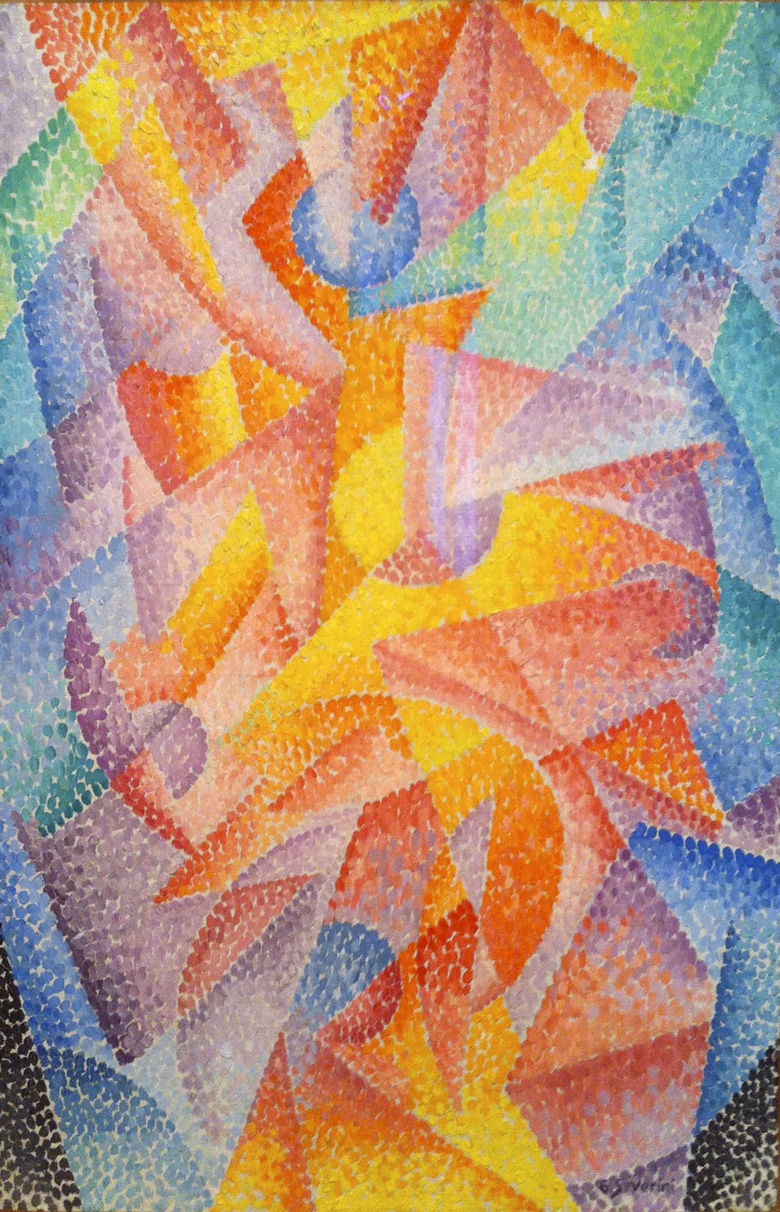Futurism, the “dynamic cubism”
Futurism was the avant-garde movement born in Italy, obsessed with technology and speed.
It emerged in Milan (1909) with the poet Marinetti and is theoretically justified with manifestos dedicated to each of the visual arts.

Futurist painting can be defined as “dynamic cubism.” They aim to represent, with colour, the dynamic effect of moving objects. By painting they multiply the positions of the body, like early cinema.
The group included Italian painters, sculptors, graphic designers, musicians, architects and industrial designers.

The Futurists were revolutionaries, members of an avant-garde movement that sought to free itself from the artistic conventions of the past. With their manifestos, they managed to spread their ideas and enjoyed great success.
They idolised airplanes and automobiles because they were symbols of speed and dynamism, just how they saw the world.

The movement emerged in Milan under the protection of poets and painters. The poet Tommaso Marinetti published his Futurist Manifesto (1909) in La Gazzetta Emilia and in the French newspaper Le Figaro.
They began motivated by renewing purposes: they intended to change life and society. They proclaimed their hatred of museums and their adherence to the latest advances of civilization. The past was not worthy of admiration, but of contempt.
We, the young and strong futurists, have nothing to do with the past!
They make clear their desire to reestablish Italy as a new cultural center. The country, whose unification was very recent (1870), still hailed the glory of the Roman Empire and the Italian Renaissance. But for them, it was nothing interesting.

We will free Italy from its innumerable museums, which cover it as if they were innumerable cemeteries.
The beauty of the industrial discoveries of the 20th century was much more fascinating to them than classical painting and sculpture. They saw modern industrial inventions as much more attractive.
We declare a new aesthetic: the beauty of speed. A racing car is more beautiful than the Victory of Samothrace.
Around Marinetti were a group of young artists who shaped the movement with their visual arts. The music composer Luigi Russolo and the painters Umberto Boccioni, Carlo Carrà, Giacomo Balla and Gino Severini were part of the original group.

The manifesto also exalted violence and the necessity of war, but curiously it did not propose any artistic rules. This would come later, with the Technical Manifesto of Futurist Painting (1914) signed by five painters. In their text they praised originality and dynamism.
There were many manifestos as the group members wrote about all kinds of topics, from architecture and religion to fashion.
They adhered to the principles of “universal dynamism,” meaning that no individual object is separate from its environment or from another object.
The sixteen people that surround you on a rolling motor bus are in turn and at the same time one, ten, four, three… they are motionless and change places. The bus rushes towards the houses it passes, and in turn the houses throw themselves on the bus and mix with it.
An example is Giacomo Balla‘s painting Dynamism of a Dog on a Leash. The movement of walking a dog is shown with the multiplication of the dog’s legs, the leash and the owner’s legs. Urban scenes like this were typical of the futurists, who saw the city environment as the culmination of their ideals.

Some focused on the sound sensations of the art. Umberto Boccioni was inspired by noise to paint his works. He himself explained the principles of futurist art, distinguishing it from impressionism, another avant-garde movement.
While the Impressionists paint a picture to portray a particular moment and subordinate the life of the canvas to its likeness to this moment, we synthesise each moment (time, place, shape, color tone) and thus create the work.
The Futurists were also heavily influenced by Cubism, which was introduced to the group by Gino Severini. He discovered it during his visit to Paris in 1911, introducing his use of fragmented colour fields and short brush strokes.

His fellow artists used cubist techniques to create even more dynamic scenes, depicting cyclists, dancers, and cities under construction.
Boccioni took his work from two to three dimensions and created his famous sculpture Unique Forms of Continuity in Space (Museum of Modern Art, New York). Streamlined and fluid, it is an emblematic piece as it represents his new obsession with sculpture and his ability to suggest movement.
The beginning of World War I marked the end of the original Futurist group. Boccioni was drafted into the Italian army and killed in 1916. It was a big blow for everyone.
After the war, Marinetti managed to revived the movement. This period was called Second Futurism and was associated with Fascism. They considered Italy to be divided between the industrialised north and the agricultural south and wanted to build a bridge to unite them. Marinetti launched his own political program. His violent warmongering is reflected in another Manifesto (1913) where he defends colonial expansion, anticlericalism, heroism and the cult of sport.

The Futurist Political Party was absorbed by Benito Mussolini’s Fascist Party, although Marinetti ended up disagreeing with his principles and retired from political life. Post-war Futurism gave life to new types of expression.
Futuristic Aeropittura (Aerial painting) became a popular style in the 1920s. Most of the painters were pilots and were fascinated with flying. It combined a love of flight with aerial landscapes and was used as propaganda.
Aeropittura was born with the 1929 Manifesto “Perspectives of Flight” signed by Benedetta Cappa, Fortunato Depero, Gerardo Dotori, Fillia, Marinetti, Enrico Prampolini and Tullo Cralli. It was not limited to landscapes as its themes were varied. It was popular until 1940.

Currently the Futurist movement is known for its attitude of admiration for speed, violence and youth as an attempt to advance culturally.
With their fascination with the new industries and their excitement for the future, the futurists of the 20th century found their place in history.
